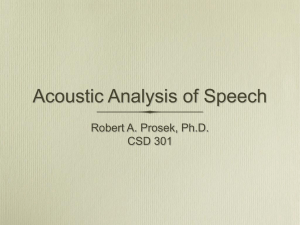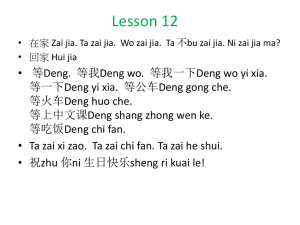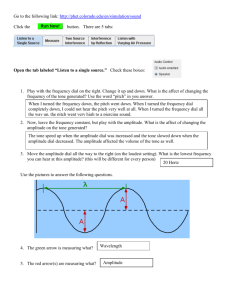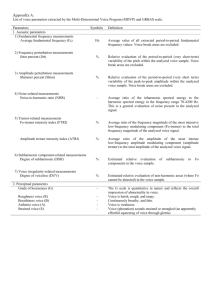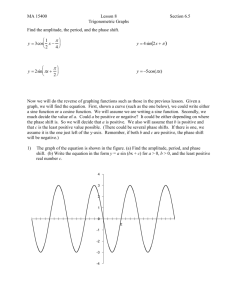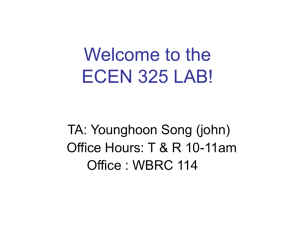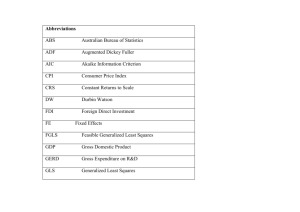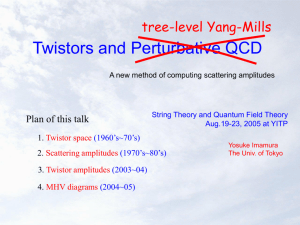Geometric Picture for Scattering Amplitudes
advertisement
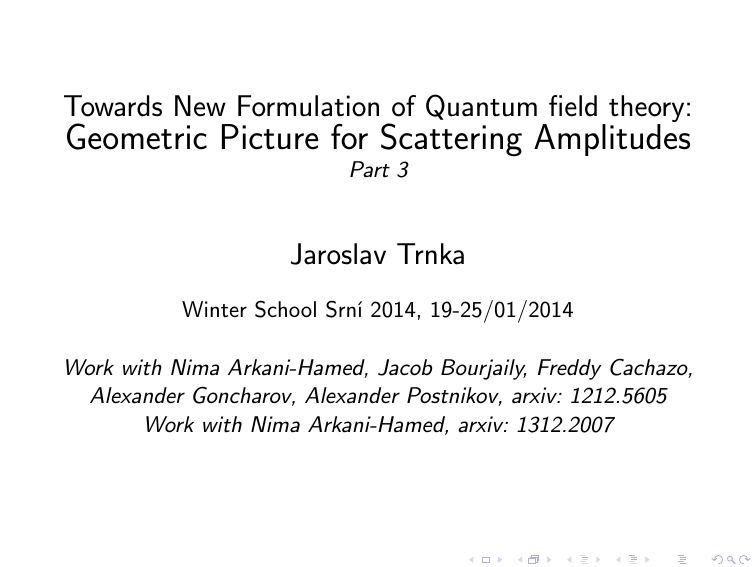
Towards New Formulation of Quantum field theory: Geometric Picture for Scattering Amplitudes Part 3 Jaroslav Trnka Winter School Srní 2014, 19-25/01/2014 Work with Nima Arkani-Hamed, Jacob Bourjaily, Freddy Cachazo, Alexander Goncharov, Alexander Postnikov, arxiv: 1212.5605 Work with Nima Arkani-Hamed, arxiv: 1312.2007 The Amplituhedron Review of the result I I I For each amplitude A`−loop we define a positive space n,k ”Amplituhedron” Pn,k,` - it is a generalization of the positive Grassmannian. For each positive space we associate a form Ωn,k,` which has logarithmic singularities on the boundary of this region. . From this form we can extract the amplitude A`−loop n,k I Calculating amplitudes: triangulation of the positive space Pn,k,` in terms of building blocks for which the form is trivial. I Set of on-shell diagrams (given by recursion relations) provides one particular triangulation. The New Positive Region Inside of the simplex I Problem from classical mechanics: center-of-mass of three points Imagine masses c1 , c2 , c3 in the corners. x~T = I I c1 x~1 + c2 x~2 + c3 x~3 c1 + c2 + c3 Interior of the triangle: ranging over all positive c1 , c2 , c3 . Triangle in projective space P2 . I Projective variables Zi = I Point Y inside the triangle. 1 x~i Y = c1 Z1 + c2 Z2 + c3 Z3 Inside of the simplex I Generalization to higher dimensions is straightforward. Point Y inside tetrahedon in P3 : Y = c1 Z1 + c2 Z2 + c3 Z3 + c4 Z4 Ranging over all positive ci spans the interior of the simplex. I In general point Y inside a simplex in Pm 1 : Y I = C1a ZaI I where I = 1, 2, . . . , m C is (1 × m) matrix of positive numbers, C = (c1 c2 . . . cm )/GL(1) which is G+ (1, m) Into the Grassmannian I Generalization of this notion to Grassmannian. I Let us imagine the same triangle and a line Y , (1) (1) (1) (2) (2) (2) Y1 = c1 Z1 + c2 Z2 + c3 Z3 Y2 = c1 Z1 + c2 Z2 + c3 Z3 writing in the compact form YαI = Cαa ZaI where α = 1, 2 I The matrix C is a (2 × 3) matrix mod GL(2) - Grassmannian G(2, 3). I Positivity of coefficients? No, minors are positive! 1 0 −a C= 0 1 b Into the Grassmannian I In the general case we have YαI = Cα a ZaI where α = 1, 2, . . . , k, ie. it is a k-plane in (k +m) dimensions, a, I = 1, 2, . . . k +m. Simplex has α = 1, for triangle also m = 2. I The matrix C is a ’top cell’ (no constraint imposed) of the positive Grassmannian G+ (k, k +m), it is k · m dimensional. I We know exactly what these matrices are! Beyond triangles I Let us go back to point inside a triangle. I Points Zi did not play role, we could always choose the coordinate system such that Z is identity matrix, then Y ∼ C. I If the number of points n > k +m the position of vertices is crucial. For a given cyclic ordering we consider the interior of the polygon in P2 . We need a convex polygon! Beyond triangles I Convexity = positivity of Z’s. They form a (3 × n) matrix with all ordered minors being positive, hZi Zj Zk i > 0 I for all i < j < k The point Y inside this polygon is Y I = c1 Z1 + · · · + cn Zn = C1a ZaI I where C ∈ G+ (1, n) and Z ∈ M+ (3, n). Note that point Y is also inside some triangle Beyond triangles I Triangulation: set of non-intersecting triangles that cover the region. n X Pn = [1 i i +1] i=2 I The generic point Y is inside one of the triangles. The matrix: C = 1 0 . . . 0 ci ci +1 0 . . . 0 I Two descriptions: I I Top cell (n 1)-dimensional of G+ (1, n) - redundant. Collection of 2-dimensional cells of G+ (1, n) - triangulation. Tree Amplituhedron I In general case we have I I A k-plane Y in (k+m)-dimensional space. Positive region given by n points Zi with positive constraints, hZa1 Za2 Za3 . . . Zak+m i > 0 I for a1 < a2 < a3 < · · · < ak+m The definition of the space: YαI = Cα a ZaI α = 1, . . . , k, I = 1, . . . , k+m, a = 1, . . . , n I Note that the geometric statement being ”inside”does not generalize while the positivity of all (k × k) minors does. I It is a map that defines a positive region Pn,k,m , G+ (k, n) × M+ (k +m, n) → G(k, k +m) I The tree-level amplitude for n, k corresponds to the case n, k and m = 4. Canonical forms Canonical form I How to get the actual formula from the positive region? I We define a canonical form ΩP which has logarithmic singularities on the boundaries of P . I Example of triangle in P2 : ΩP = I We parametrize Y = Z1 + c2 Z2 + c3 Z3 and get ΩP = I hY dY dY ih123i2 hY 12ihY 23ihY 31i dc2 dc3 = dlog c2 dlog c3 c2 c3 This is just a form for the top cell of G+ (1, 3), C = 1 c2 c3 Canonical form I Simplex in P4 - this is relevant for physics. ΩP = hY dY dY dY dY ih12345i2 hY 1234ihY 2345ihY 3451ihY 4512ihY 5123i For Y = Z1 + c2 Z2 + c3 Z3 + c4 Z4 + c5 Z5 : ΩP = dlog c2 dlog c3 dlog c4 dlog c5 I This is a 4-dimensional (top) cell in G+ (1, 5). C = 1 c2 c3 c4 c5 I The form ΩP gives the n = 5, k = 1 tree-level scattering amplitude. Canonical form I For general D-dimensional cell of Positive Grassmannian there is an on-shell diagram associated with each cell. I We parametrize the C matrix with D positive parameters. and the logarithmic form is ΩP = dlog c1 dlog c2 . . . dlog cD I Then we can solve for parameters cj using YαI = Cαa ZaI and get the form in Y . Canonical form I This is not enough for us. Our space is km dimensional and it is an image of k(n − k)-dimensional top cell of G+ (k, n) under the map YαI = Cα a ZaI I I I I α = 1, . . . , k, I = 1, . . . , k+m, a = 1, . . . , n There is a form Ω with logarithmic singularities on the boundaries of this space. It is not the dlog of all variables unlike for the cell of G+ (k, n). Matrix C is parametrized using k(n − k) parameters but the space is only km dimensional. We wish to find the form just from definition. Alternative method: triangulate the space - find a collection of km dimensional cells of G+ (k, n) that cover the whole region for Y like in polygon case. Then the form is just a sum of dlog forms for each cell (after solving for parameters cj in terms of Y and Zi ). Canonical form I Example: Polygon ΩP = n X i=2 hY dY dY ih1 i i +1i2 hY 1 iihY 1 i +1ihY i i +1i Spurious poles hY 1 ii cancel in the sum. I We can also look directly for the form Ω= hY dY dY i N (Y, Zi ) hY 12ihY 23ihY 34i . . . hY n1i and fix the numerator from the condition that singularities are logarithmic only on the boundaries of the polygon. Canonical form I The case of physical relevance is m = 4. I Tree-level Amplituhedron Pn,k,4 defined by YαI = Cα a ZaI α = 1, . . . , k, I = 1, . . . , k+4, a = 1, . . . , n I There is a form with logarithmic singularities on the boundary of this space. I Recursion relations provide a triangulation of this space in terms of building blocks, 4k-dimensional cells of Positive Grassmannian G+ (k, n). I There exist many other triangulations. From canonical forms to amplitudes I How to extract the amplitude from ΩP ? I Look at the example of simplex in P4 . ΩP = hY dY dY dY dY ih12345i4 hY 1234ihY 2345ihY 3451ihY 4512ihY 5123i I Note that the data are five-dimensional, it is purely bosonic and it is a form rather than function. I Let us rewrite Zi as four-dimensional part and its complement zi where δzi = (ηi · φ) Zi = δzi 0 ∗ We define a reference point Y which is 0 ∗ Y = 0 in the complement of 4d data zi , 0 1 From canonical forms to amplitudes I We integrate the form, using hY ∗ 1234i = h1234i, etc. we get Z Z (h1234iη5 + h2345iη1 + · · · + h5123iη4 )4 4 d φ δ(Y −Y ∗ ) ΩP = h1234ih2345ih3451ih4512ih5123i I For higher k we have (k +4) dimensional external Zi , ~0 ~0 . . . zi (ηi · φ1 ) 1 0 ... Zi = Y∗ = . . . .. .. .. .. . (ηi · φk ) 0 0 ... I ~0 0 .. . 1 Reference k-plane Y ∗ orthogonal to external zi . We consider integral Z Z 4 4 An,k = d φ1 . . . d φk δ(Y − Y ∗ ) ΩPn,k Loop amplitudes MHV amplitudes I The simplest case is k = 0 where there is no Y -plane – MHV amplitudes. The space is just P3 and the tree-level form is just ΩP = 1. I The loop momentum is represented by a line ZA ZB . We consider all configurations of this line. I For one line we can parametrize AIα = Cα a ZaI , where α = 1, 2 where Aα = (A, B). I We demand the matrix of coefficients to be positive, ie. C ∈ G+ (2, n) and Z ∈ M+ (4, n). I The form with logarithmic singularities on the boundaries of this space is MHV 1-loop amplitude. I We know the explicit form of the result by triangulation. MHV amplitudes I ”Triangles”are just 4-dimensional cells of G+ (2, n): ”kermits” C1,i,i +1;1,j,j +1 = I 1 −1 0 0 0 0 ci 0 ci +1 0 0 0 0 0 0 cj 0 cj +1 0 0 0 0 Triangulation Pn = X [1, i, i +1; 1, j, j +1] i<j where each kermit has a simple form ΩP = dlog ci dlog ci +1 dlog cj dlog cj +1 I The form for the full space is then ΩP = X i<j T hABd2 AihABd2 BihAB(i 1 i i +1) (j 1 j j +1)i2 hAB 1 iihAB 1 i +1ihAB i i +1ihAB 1 jihAB 1 j +1ihAB j j +1i MHV amplitudes I In the next case we consider two lines in P3 , denoted as ZA ZB , ZC ZD , I A(1) α Aα(2) I = = Cα(1)a ZaI Cα(2)a ZaI We combine matrices into (1) C C= C (2) I We demand C (1) , C (2) to be both G+ (2, n). This is a ”square”of one-loop problem: (A1−loop )2 . n I Additional constraint: All (4 × 4) minors of C are positive! I The form with log singularities is MHV two-loop amplitude. I The space of C matrices is a generalization of positive Grassmannian and has not been studied in the literature - we do not know the stratification (even before applying Z-projection). MHV amplitudes I At L-loop we have L lines AIα . Aα(1) I = Cα(1)a ZaI .. . I I A(L) = Cα(L) α a Za I Positivity constraints: I I I I C (1) C = ... C (L) External data Z are positive. All minors of C (j) are positive. All (4 × 4) minors made of C (i) , C (j) are positive, all (6 × 6) minors of C (i) , C (j) , C (k) , etc. are also positive. The form is the integrand of n-pt L-loop MHV amplitude. The Amplituhedron In the general case of n-pt L-loop Nk MHV amplitude we have I Positive k +4-dimensional external data Z. I k-plane Y in k +4 dimensions I L lines in 4-dimensional complement to Y plane YσI = Cσ a ZaI Aα(1) I = Cα(1)a ZaI .. . C= I I = Cα(L) A(L) α a Za C C (1) .. . C (L) Positivity constraints: I C is positive. I C + any combination of C (i) ’s is positive. Application: Four point amplitudes Four point amplitude I I We have L lines in P3 represented by L positive Grasmannians G+ (2, 4). All 4 × 4 minors made of pairs of G+ (2, 4) are positive. Zs are totally irrelevant here, n = m = 4. In one parametrization, 1 x1 0 −v1 1 xL 0 −vL C1 = . . . CL = 0 y1 1 u1 0 yL 1 uL All coefficients xi , yi , ui , vi > 0 and there is a set of inequalities (xi − xj )(ui − uj ) + (yi − yj )(vi − vj ) < 0 I for all pairs i, j. There is a way how to phrase this problem purely geometrically. Let us define xi vi ai = bi = yi ui Four-point amplitude We have 2d vectors ai , bi for i = 1, . . . , L and we demand I They all live in the first quadrant. I For any pair (ai − aj ) · (bi − bj ) < 0. I Triangulation: Find all possible configurations of vectors! We do not know how to solve it in general but we have some partial results. One-loop amplitude I This is a ”free”case, G+ (2, 4). We have a single line in P3 parametrized by 1 x1 0 −v1 C1 = 0 y1 1 u1 with x1 , y1 , u1 , v1 > 0. I Therefore the form with logarithmic singularities on the boundaries (0 and ∞ for all variables), is Ω= dx1 dy1 du1 dv1 x1 y1 u1 v1 Two-loop amplitude I This is a first ”interacting”case. C1 = 1 x1 0 −v1 0 y1 1 u1 C2 = 1 x2 0 −v2 0 y2 1 u2 where all variables are positive and satisfy (x1 − x2 )(u1 − u2 ) + (y1 − y2 )(v1 − v2 ) < 0 I This is a quadratic condition and in order to write bounds for all variables we have to triangulate the region – there are several top form. I The final result is then: (u2 x1 + u1 x2 + v1 y2 + v2 y1 ) x1 x2 y1 y2 u1 u2 v1 v2 [(x1 − x2 )(u1 − u2 ) + (y1 − y2 )(v1 − v2 )] Cuts of the amplitude I We do not know how to triangulate the amplitude in general. The system of inequalities is too hard for us at the moment. I However we can solve some special cases - cuts of the amplitude: we can generate many data not accessible using any other approach. I One example: all vi = 0 1 x1 0 0 C1 = 0 y1 1 u1 I ... CL = 1 xL 0 0 0 yL 1 uL It is the single cut of the amplitude h(AB)i 12i = 0 (xi − xj )(ui − uj ) < 0 I Solution: we consider all orderings of x’s: x1 < x2 < . . . xL and then y’s are ordered in the opposite order y1 > y2 > . . . yL . Conclusion Conclusion Mathematics I Amplituhedron is a significant generalization of positive Grassmannian which is of high interest in QFT. I Interesting directions: triangulation of this space in terms of more elementary building blocks, understanding stratification of this space. Physics I Amplituhedron is a new geometric picture for scattering amplitudes in planar N = 4 SYM. I It is defined purely in geometric terms with no reference to usual concepts of QFT: no Lagrangians, locality or unitarity which are all emergent properties from geometry. I Interesting directions: calculate all-loop order results, generalization of the picture to other theories.
